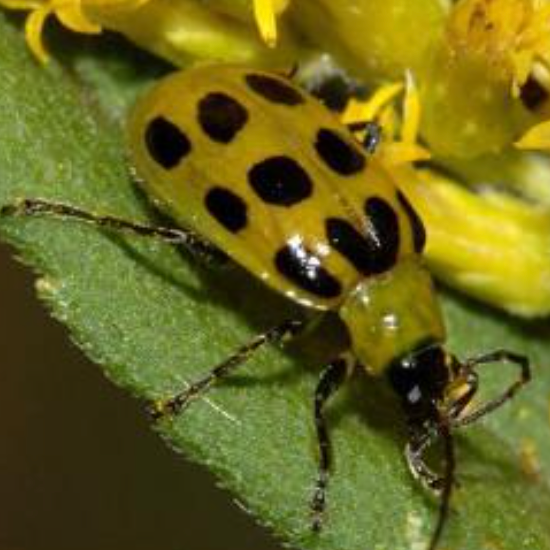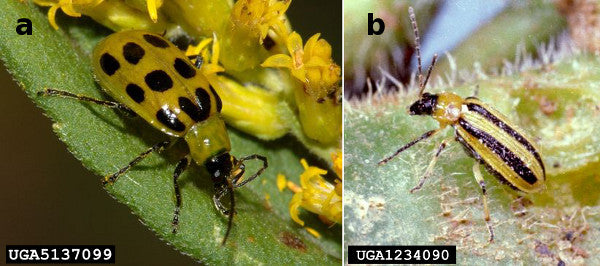
Bug Profile: Cucumber Beetles
 Figure 1. Cucumber beetles. (a) western spotted cucumber beetle (b) Striped cucumber beetle. Photo credits: (a) Susan Ellis, Bugwood.org; (b) Clemson University - USDA Cooperative Extension Slide Series, Bugwood.org
Figure 1. Cucumber beetles. (a) western spotted cucumber beetle (b) Striped cucumber beetle. Photo credits: (a) Susan Ellis, Bugwood.org; (b) Clemson University - USDA Cooperative Extension Slide Series, Bugwood.orgA garden without bugs is no garden at all. Insects and plants have complex and close relationships, which gardeners can only aspire to fully understand. As we encounter pesky and beneficial insects on our farm this season, we’ll be profiling them here, in an effort to help gardeners know how to better interact with bugs in the garden.
Our first significant pest encounter this year was with cucumber beetles. Last week, we opened up the hoop house to find most of our cucurbit seedlings filled with Swiss cheese-like holes and lots of striped yellow and black beetles sitting on and around the young plants.
Cucumber beetles are small oval-shaped insects, yellow and black in color, striped or polka-doted in pattern, that can be found nearly anywhere in North America - their native land. The beetles love to feed on all cucurbits, including melons, watermelons, winter and summer squashes, and, of course, cucumbers. They will also, on occasion, attack other crops such as beans, corn, or potatoes.
In our northern climate, there is enough time in a growing season for two generations of beetles to emerge. In warmer areas, the beetles could go through three of their 8-week life cycles. The beetles cause damage to the poor cucurbits four different ways. First, in the spring, adult beetles will feed on (more specifically, suck out the moisture and nutrients from) cucurbit seedlings and as the seedlings are still young and highly sensitive, the bugs can devastate the plants. They then proceed to lay eggs in the soil around the seedlings. Once the larvae hatches, it begins to feed on a cucurbit’s roots, sometimes chewing whole tunnels into the root systems. Although larval damage is generally mild, the larvae then grows into full beetles, which emerge out of the ground in early July, just as the cucurbits begin to bloom with vigor. Many damaged flowers will means fewer and poorer fruits. The second generation of beetles is born in the fall, to once again repeat the cycle. And, as if physical damage wasn’t enough, the cucumber beetles’ worst impact actually comes from causing plant disease, including squash mosaic virus, powdery mildew, black rot, and worst of all: bacterial wilt. Cucumber beetles are carriers of the bacteria Erwinia tracheiphila, which causes bacterial wilt and, by preventing nutrients from traveling through the plant, can kill a healthy cucurbit in as little as seven days. Fortunately, there is an arsenal of organic solutions for keeping beetles at bay:
If you already know that cucumber beetles frequent your garden, take proactive measures:
Trap crop, trap beetle. A week or two before your cucurbit planting date, plant a border of decoy cucurbits around your prepared planting area. This border planting will be sacrificed to the cucumber beetles. The bugs will be attracted to this area, which will make the rest of your cucurbit beds less appetizing to them and will make it easier to take control measures as the beetles will be concentrated in one area.
Plant Late. If you can muster the patience to wait a few extra weeks before tasting the season’s first cucumber, then delaying your cucurbit planting until after the first cycle of cucumber beetles passes will pay off. Not only will this help your plants avoid battling with the beetles, but will also allow them to grow bigger, stronger, and more prepared for the next time they face the beetles.
Cover Up. When we transplant cucurbit seedlings into our field, we cover them immediately with a floating or hooped (LINK) row cover. This not only creates a barrier for the cucumber beetles from accessing the plants, but gives the seedlings time to grow larger roots and foliage and thus be better prepared for a bug attack in the future. Don’t forget to remove the cover once the plants start flowering to allow for pollination!
If the beetles attack:
Hand Pick. This is what it sounds like. If beetles attack at the seedling stage, remove as many as you can (and smush them or transport to a new home far far away), then cover the plants to prevent more beetles from landing on them. If hand picking is not for you, sticky traps can be effective too - attach a little tea bag to the sticky paper with attractive floral scents that the beetles love, such as cinnamon, cloves or bay leaves.
Spray with soap or clay. Soapy water sprayed directly on the beetles will dehydrate them, killing them within a minute. Some growers coat their cucurbits with a spray of kaolin clay (mixed with water). When the beetles come in contact with the clay, they get dusty and have to focus entirely on cleaning themselves, rather than destroying the plant.
Post attack:
Clean Up. Preventative measures in the fall will make for a better season the next spring. Cucumber beetles overwinter in the soil. To cut down on their population, be sure to remove all leftover plant bits, till thoroughly, apply compost, and plant cover crops. If you encounter diseased plants, they should be discarded separately, away from your main compost pile.
To learn more about managing cucumber beetles organically, take a look at this information from Cornell University.






